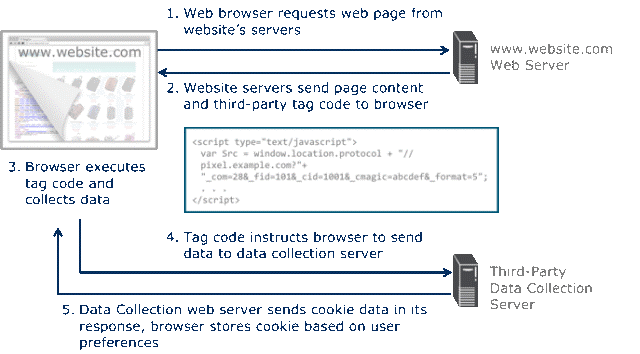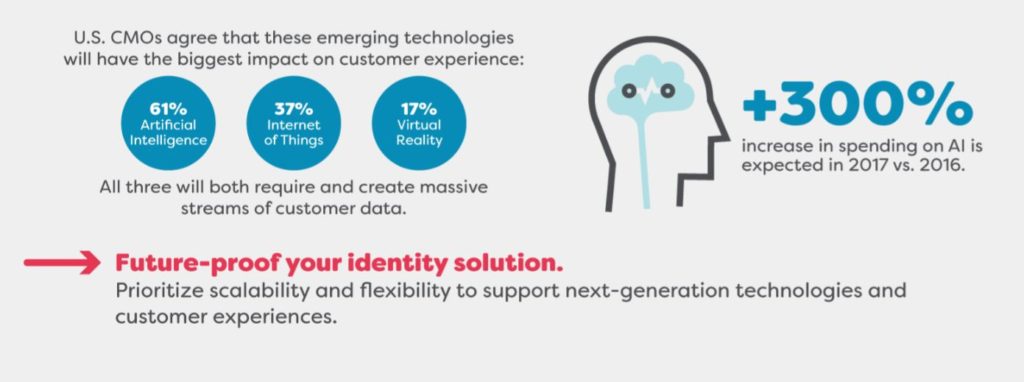A couple of weeks ago, I wrote the first section of this article explaining the basics of Tag Management as it relates to what tags are and what information they collect. This second article covers what happens behind the scenes each time we visit a website.
How do tags collect and send data?
When a user’s browser loads a webpage, the tag tells the browser to connect to a third-party marketing or analytics provider’s server for the purposes of data collection. The multi-step process looks something like this:

What are some of the drawbacks associated with tags?
Despite a tremendous amount of innovation in online marketing, the tag-driven method of gathering data from website activity has not changed since the 1990s. Tags often create internal conflict between marketing, IT and privacy stakeholders and can introduce some challenging points for everyone involved in online marketing.
- Control and Ownership: When a site owner puts third-party code on their site, control over the data collection process is ceded to the third-party provider. The more tags, the more third parties with control over the site owner’s data.
- Implementation: The traditional process of managing multiple third-party tags is a well-known operational challenge that requires site owners to place custom code on specific pages of their site. For many large brands, this typically requires the IT team or the hosting company to make the changes as part of a scheduled deployment process which can delay campaigns and lead to lost revenue opportunities.
- Privacy: Multiple tags on a website put privacy at risk because third parties have access to the data collected on the site (see Control and Ownership above). Also, many brands must adapt their sites to comply with privacy regulation across markets and geographies which becomes increasingly difficult when data collection is in the hands of third parties.
- Performance: Every new tag added to a site can introduce additional latency (read: additional load time) and degrade the customer experience. It is the end user visiting the website who bears the brunt of this overhead when they load pages containing hundreds of lines of third-party code.
- Data loss: Sometimes tags fail to fire. For every failed tag, data is not collected and revenue opportunities may be lost.
- Piggybacking: It is possible for tags to be chained together through a process called “piggybacking.” This enables tags to be appended to existing tags already in place on the website without making any changes to the page code. Piggybacking can add dozens of tags to a site and introduce services that the site owner may not be aware are on the site. In other words, ad networks can chain together ad server tags in order to increase audience reach across multiple publisher sites.
What is a tag container?
The tag container was originally introduced a decade ago by the major ad networks as a way to add a lot of tags to a website and manage them all in one place. Most online marketing professionals are familiar with Doubleclick’s Floodlight tag or the Atlas Universal Action Tag (UAT).
Containers are intended to make it easy to add a lot of tags to a website by injecting them into the browser through JavaScript or an invisible frame. Many companies offer more sophisticated versions of the tag container to address the growing complexity and operational challenges introduced by multiple third-party tags.
What are the limitations of tag containers?
At its core, a tag container is still sending third-party code through the end user’s browser putting data ownership, performance or privacy at risk. There is also a danger of data loss for the site owner and third-party provider when browser tags don’t fire properly. Tag containers do not solve for the inevitability of tags going dark. When it comes to scalability and performance, tag containers are dependent on optimizations to the browser which is yet another third-party service the site owner does not control.

In sum, programmatic advertising and the use of artificial intelligence to manage your ad campaigns will just continue to evolve in the coming years. Managing your data, controlling your message and placements and dealing with any of the potential drawbacks is just part of the process.
If you have any questions, or need assistance setting up your next programmatic campaigns, please contact out team at MGR Consulting Group and we will work with your team to decide what is best for you.
Thank you for reading. Until next time, this is Manuel Gil del Real (MGR)
Sources: Signal.com, Sojern.com, Wordstream.com, DoubleClick.com




